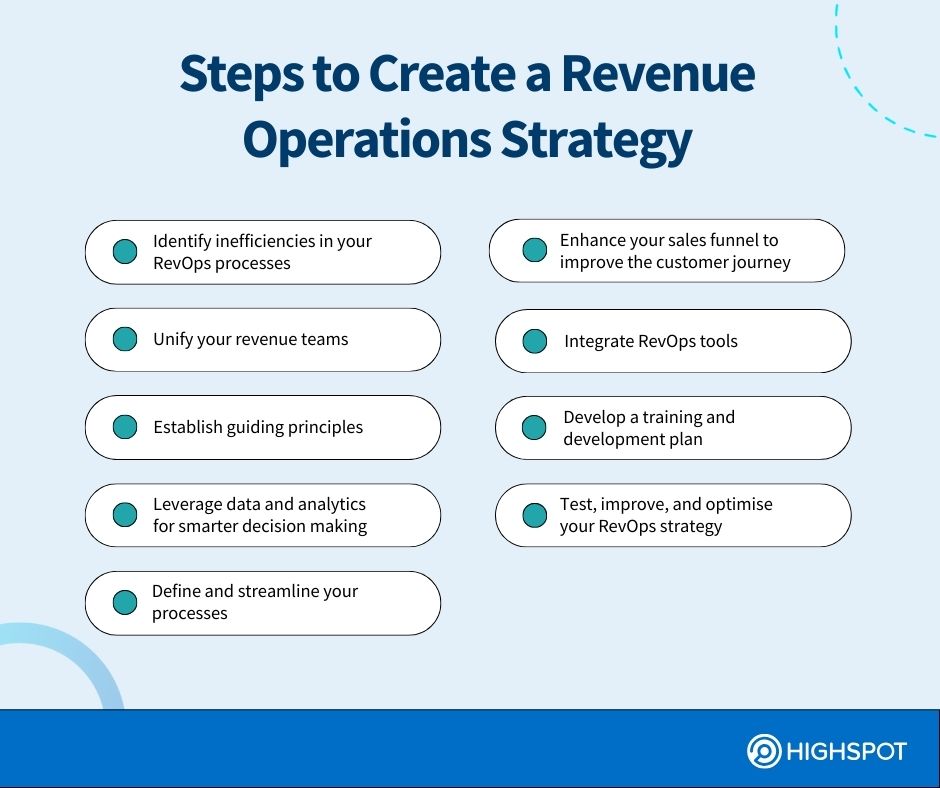Nowadays, it’s not enough to close a deal and call it a day—even more so to rely on past growth to predict the future. B2B companies must make fast, smart decisions to drive revenue growth and scalability.
Leaders quickly realise the importance of revenue operations (RevOps) and how aligning go-to-market teams under one unified approach can boost performance, improve operational efficiency, and increase revenue. However, adopting RevOps requires a mindset shift and strong stakeholder commitment.
In this article, we’ll explore the changes necessary to successfully implement a RevOps strategy and outline nine practical steps to help you get started, complete with real-world examples.
Key Takeaways
- An effective revenue operations strategy streamlines every touchpoint of the customer journey and prevents disjointed experiences.
- Implementing a RevOps strategy involves changing how your organisation thinks and operates.
- Alignment of data, information, and tech stack is fundamental to the success of your RevOps initiatives.
What is a Revenue Operations Strategy?
A revenue operations strategy outlines the steps, objectives, and KPIs needed to maximise revenue growth. It brings sales teams, marketing, and customer operations and success together to streamline end-to-end processes and ultimately deliver the seamless customer experience that today’s buyers demand.
The Importance of a Revenue Operations Strategy
Today’s customers expect every interaction with B2B businesses, especially SaaS companies, to flow smoothly from one step to the next. If even one part of the process falters, their entire experience is compromised. And here’s the kicker: 32% of customers say they’d stop doing business with a brand they love after just one bad experience. That’s nearly one-third of your customer base at risk from a single misstep.
That said, you must ensure all teams work in sync to build strong customer ties and stay competitive. This is where a RevOps strategy comes in. Aligning all revenue-generating departments through shared information, data, and technology provides a 360-degree view of the customer journey, preventing disjointed experiences that can put the customer relationship at risk.
9 Steps to Create a Revenue Operations Strategy
To avoid the pitfalls that lead to poor customer experiences and lost revenue, you need a strong RevOps strategy. This means systematically managing the entire customer journey—from generating leads and closing deals to handling renewals and upsells. Every step should flow seamlessly.
However, implementing a RevOps strategy is more than a new sales process and tools; it involves changing how your organisation thinks and operates.
- Change management: Many processes will go through a change management flow. Incorporate how you will communicate RevOps’ benefits and vision to all team members. Provide support and resources throughout the transition to minimise resistance and encourage buy-in.
- Stakeholder buy-in: Engage stakeholders early as you explore implementing a RevOps strategy. Ensure they understand its value and how it aligns with your business’s direction. Regular updates and transparent communication can help maintain their support and address concerns.
- Cultural shift: Moving to a RevOps model is a cultural shift towards greater collaboration and data-driven decision-making. Create a culture of openness and teamwork that discourages working in silos.
Addressing these organisational shifts lays a more robust foundation before implementing a massive systematic change.
Here’s how you can achieve a winning RevOps strategy:

1. Identify Inefficiencies in Your Revenue Operations Processes
The first step is to identify the problems you want to solve. Start by conducting an audit of your current workflows. This means looking closely at every part of your RevOps team to understand where things might fall apart.
Some areas to explore include:
Overburdened Sales Reps
Are your sales reps stretched too thin? If they spend more time on administrative tasks than selling, it’s a sign that responsibilities, technology, and processes may need a closer look. Consider removing non-sales tasks from their plates using automation tools or support staff to handle these duties.
Poor Qualification
If your salesforce talks to too many leads that don’t convert, you may have a qualification issue. Create an Ideal Customer Profile (ICP) or detailed buyer personas to define your target audience. Then, implement a lead scoring system based on these profiles to prioritise the leads most likely to buy. Focusing on the most promising prospects saves your sales team time and increases conversion rates.
Delayed or No Follow-up
Are leads slipping through the cracks because of slow or non-existent follow-ups? This could happen for several reasons, such as a lack of automation, unclear follow-up procedures, or sales reps not knowing what to say.
Start by automating follow-up sequences with tools that send reminders and emails with valuable content to keep leads engaged without extra manual effort. Provide training and scripts to help sales reps understand what to say and when. Finally, implement a standardised follow-up process to ensure consistency and accountability across your revenue operations team.
Fragmented Tech
Is your team using too many different tools that don’t talk to each other? This often leads to duplicated efforts, missed opportunities, and increased frustration. Look for signs to determine if you have a fragmented tech stack.
One of the most common indicators is the presence of data silos, where information is stored in multiple locations, making it difficult to get a unified view of customer data or sales activities. You might also notice that reps spend a lot of time on manual data entry, transferring information between systems rather than focusing on selling.
Inconsistent processes across departments can be another red flag, especially if different teams use separate tools for similar tasks. Additionally, if team members frequently complain about the difficulty of using specific tools or the lack of integration between systems, this could be a sign of poor user experience.
To address this, consider conducting a tech stack audit to identify redundant tools and gaps in integration. Consolidating your tools into a single source of truth that integrates seamlessly across all departments can help reduce chaos.
Process Gaps and Overlaps
Process gaps and overlaps happen when teams within an organisation are not on the same page. For example, sales and marketing teams may have different criteria for what qualifies a lead, or product teams may not be clear about features and benefits, resulting in under- or overpromising.
Once you’ve identified your unique pain points, prioritise fixing those that will bring the most significant improvements to your overall revenue operations. This will improve internal collaboration and create more cohesive messaging that enhances the customer experience.
2. Unify Your Revenue Teams
Aligning your revenue teams breaks down silos and improves the customer experience. This involves promoting open communication and establishing shared objectives across all departments, ensuring everyone from sales and marketing to customer success is in sync with joint go-to-market (GTM) and revenue goals. Regular meetings, collaborative projects, and a shared RevOps performance dashboard can help bridge gaps, track KPIs and sales progress, and foster transparency, accountability, and collaboration.
3. Establish Guiding Principles
Your RevOps function should be anchored in guiding principles that shape your team’s culture and decision-making process. These principles will create a foundation that you consistently reinforce. Here are some examples of what these guiding principles might look like in practice:
- Customer-centric approach: Every decision made within the company should prioritise the customer experience. For instance, this might involve creating policies that ensure customer feedback is collected and acted upon to improve service.
- Data-driven decision-making: Use data to inform all decisions. This could involve regularly analysing revenue streams and marketing data to identify trends. For example, if data shows a drop in conversion rates, a data-driven approach would explore potential reasons and implement targeted strategies to address them.
- Collaboration and transparency: Foster a culture of openness where departments share information and work together. This could mean regular cross-departmental meetings where teams discuss progress and challenges.
4. Leverage Data, Metrics, and Analytics for Smarter Decision-Making
Reporting and forecasting are two of the most important components of a successful revenue operations strategy. To help you make informed decisions, leverage data and analytics to track key performance indicators (KPIs) and understand what’s working and what’s not. Focus on KPIs that track revenue, such as:
- Sales cycle length
- Conversion rate
- Customer acquisition cost
- Customer lifetime value
You can adjust your strategy in real-time by constantly monitoring these metrics, ensuring your RevOps strategy stays on track.
5. Define and Streamline Your Revenue Operations Processes
Start by mapping out the core processes that drive revenue, such as lead generation, sales, customer engagement, onboarding, and customer retention. Understanding these core processes helps you see how they interact and where improvements are needed. You should also set KPIs for every process and campaign, and determine what success looks like.
Then, establish standardised procedures for each stage of the revenue cycle and regularly review them to ensure they remain efficient and effective. Ensure that sales, marketing, and customer success teams understand and follow the same procedures and share relevant information to achieve common goals.
6. Enhance Your Sales Funnel to Improve the Customer Journey
A well-optimised sales funnel is necessary to provide a smooth customer journey. Analyse each stage of your funnel to detect bottlenecks that slow down progress or cause customer churn. The goal is to make the customer lifecycle as effortless as possible, leading to higher customer satisfaction and better retention rates.
For example, consider the decision stage, where prospects are evaluating whether to choose your product or service. To keep prospects thinking about your product, provide automated follow-up emails with personalised content, such as case studies, testimonials, or comparison guides highlighting your value. Be sure the content is relevant to their industry. This will build trust and guide prospects toward a purchase, leading to sustainable growth.
On the other hand, if you find that many leads drop off during the proposal stage, there is likely a problem with how the proposal is presented or perceived. Does it communicate value and relate to the prospect’s needs without overcomplicating? Are personalised ROI and benefits highlighted? Do the costs outweigh the benefits? Dig into the process; you may need more precise, compelling proposals.
7. Integrate RevOps Tools and Automate Routine Tasks
To maximise performance, reduce the number of tools your teams use and focus on integration. Implement the basics, typically a robust CRM system, sales enablement tool, marketing automation platform, and data analytics software. These tools should work together, automate repetitive tasks, and provide valuable insights.
For example, integrating your CRM with your marketing automation platform allows seamless data flow between sales and marketing operations, ensuring sales reps have the latest information about lead behaviour, engagement, and sometimes, forecasting. If a prospect downloads a whitepaper, attends a webinar, or repeatedly visits your pricing page, they likely have a high level of interest. You don’t want a sales rep pushing the same whitepaper to them. Instead, the sales rep can tailor their follow-up to schedule a call based on the prospect’s specific interests.
A well-integrated toolset ensures that data is shared in real-time across departments, reducing delays and improving the accuracy of your actions.
Related Resource: The Essential Revenue Tech Stack
8. Develop a Comprehensive Training and Development Plan
A move to RevOps can be a significant change for your team. Develop a comprehensive training and development plan to arm all team members with the skills and knowledge needed to succeed in a RevOps environment. This includes revenue enablement and training on new tools, understanding data analytics, and best practices for cross-functional collaboration.
Company-wide workshops focused on revenue operations can also be a game-changer. These sessions let sales, marketing, and customer success learn from one another, which can further improve teamwork and help transform your strategies. Continuous learning will get everyone on board and moving in the same direction.
9. Continually Test, Improve, and Optimise Your RevOps Strategy
Finally, your RevOps strategy should be a living, evolving process. Test and analyse your strategy’s performance and gather feedback from your team and customers. Consider setting up a regular review cycle—monthly or quarterly—where you assess performance, discuss challenges, and identify improvement opportunities. Continuous strategy optimisation is essential to staying agile and responsive to market changes.
Take Your RevOps Strategy to the Next Level With Highspot
Implementing the steps in this guide—breaking down silos, optimising processes, leveraging data, and fostering a culture of collaboration and continuous improvement—can transform how your organisation operates. A successful RevOps strategy requires dedication and flexibility. Regularly assess your progress, make necessary adjustments, and stay focused on your revenue goals. By embracing these changes, you’ll set your organisation up for sustainable growth and success.
If you’re ready to elevate your RevOps strategy and fully align your revenue teams, consider exploring what Highspot can do for you. Book a demo today!




